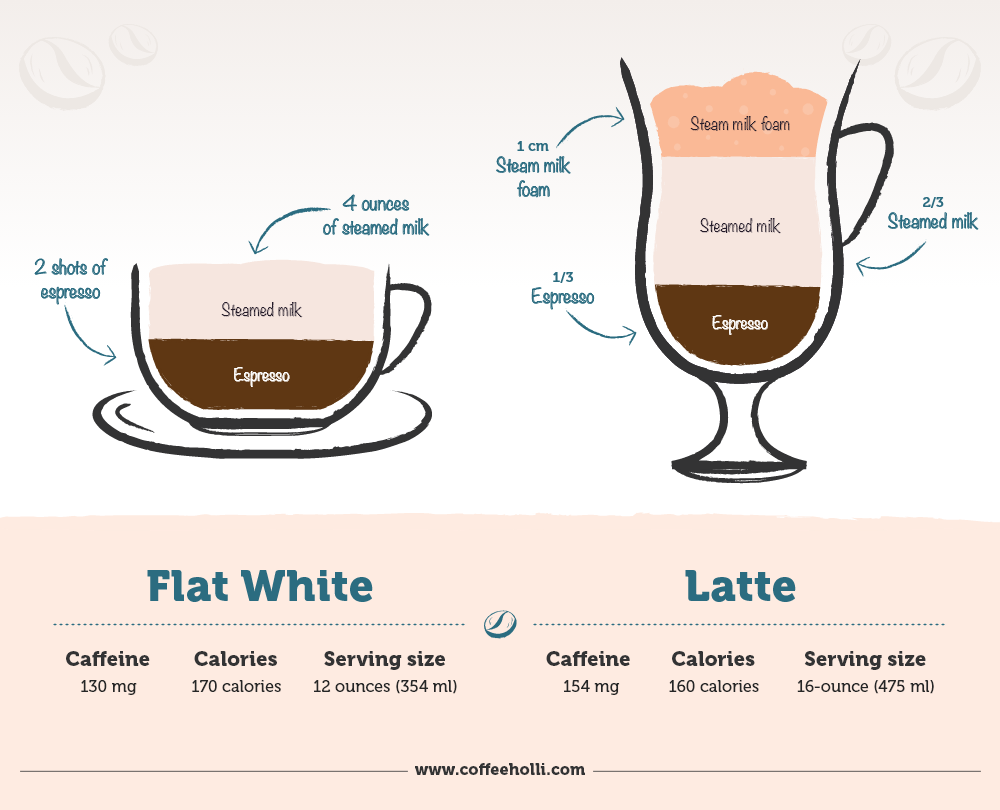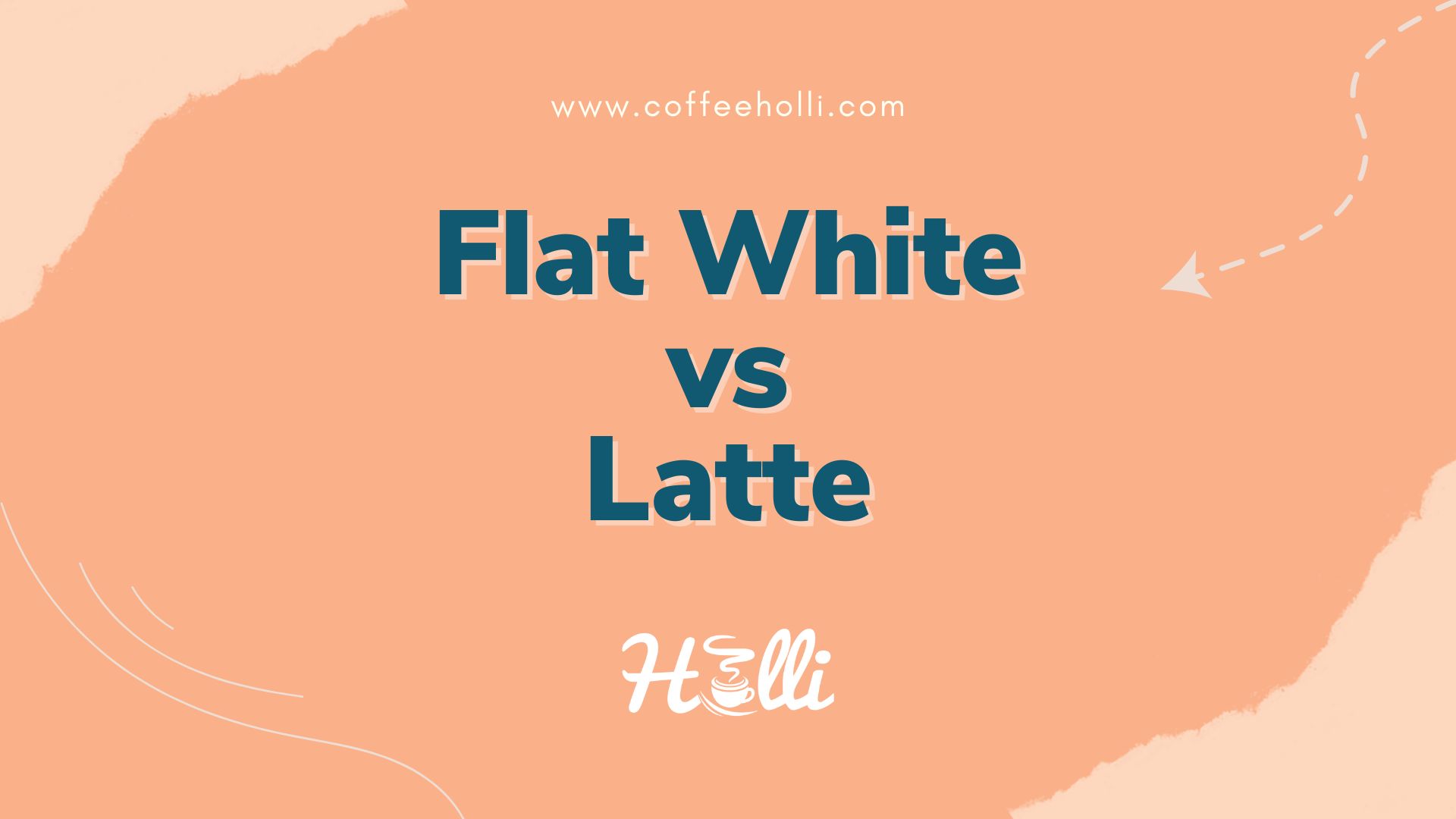
Fact.
You will have more appreciation for your cup of coffee if you understand how it was prepared. As you savor each sip, the flavors, body, and aromas will be very distinct.
To help you advance your coffee mastery skills, we will compare two of the most popular espresso-based drinks; a flat white and a latte.
While these two coffee drinks are made of the same ingredients, when prepared correctly, they taste and kick in differently.
This post goes deeper into both drinks showing you why flat white is not a milkier cappuccino or smaller latte.
Table of Contents
What is a Flat White
Now:
Unlike most espresso-based drinks that originated from Italy, flat white originated from Australia. However, New Zealanders also claim to have invented this drink.
So, who is telling the truth?
History shows that flat white was invented in Australia but perfected in New Zealand. The naming also matches how Australians label the different espresso-based drinks.
For instance, in Australia, short black refers to the regular espresso, while long black refers to the larger capacity.
While it was invented in the 1980s, it was not until 2015 that flat white started getting popular in the US, all thanks to Starbucks. Starbuck introduced flat white in the UK in 2010 and then 5 years later in the US.
How to Make a Flat White
Normally:
Flat white is prepared with 2 shots of espresso and then topped with 4 ounces of steamed whole milk. However, this ratio differs from one coffee shop to another. And from one country to another.
For instance, the Starbuck flat white is prepared with 2 ristretto shots, a thin layer of steamed whole milk, and a dot of latte art.
Now:
If you compare this with cappuccino it’s easy to differentiate. Cappuccino is prepared with equal amounts of espresso, steamed milk, and milk foam. In other words, 1:1:1 or a ⅓ of each ingredient.
On the other side, a latte is prepared with ⅓ espresso, ⅔ steamed milk, and 1cm foam.
However, the major deal in flat white is how milk is steamed.
The steamed milk is less foamy with a velvety texture. The milk is not fully foamed to gain a velvet-like texture. The microforms are very tiny and undetectable.
When it comes to taste, the flat white has a strong espresso taste since it has less milk. It’s regularly served in a 170 – 180 ml ceramic cup with no topping or flavorings.
What is the Latte
Just like a flat white, latte or Caffè latte is an espresso-based coffee drink made with espresso and steamed milk.
Today, latte and cappuccino are the most popular coffee drinks in the US and the UK.
Just like with the flat white there is contention on who invented the latte.
In the US, Lino Meiorin (an Italian-trained barista) is claimed to have invented this coffee drink in Berkeley, California back in the 1950s. On the other hand, the term latte is derived from the word Caffè latte, which dates back to the 17th century in Italy.
Fun Fact:
In Italy, if you order a latte you will be served a cup of warm milk. Latte is Caffè Latte and Italians drink it before 11 am.
How to Make a Latte
Latte is made with 1/3 espresso, 2/3 steamed milk, and 1 cm foam. 8-15 ounces of steamed milk is added in 1-2 shots of espresso.
As you can tell, the latte has more milk than espresso. In fact, latte is the milkiest espresso-based coffee drink.
Latte is prepared with either 1 or 2 shots of espresso and 8 ounces of milk and is served in a 240ml cup or mug.
Flat White Vs. Latte: Differences
| Flat White | Latte | |
|---|---|---|
| Origin | New Zealand/Australia | Italy/United States |
| Popularity | Most popular in both Australia and New Zealand | Most popular coffee drink in the US and UK |
| Ingredients | 2 shots of espresso and 4 ounces of steamed milk | 1/3 espresso, 2/3 steamed milk, and a thin layer of microfoam |
| Amount of espresso | 2 shots of espresso | 1-2 shots of espresso |
| Amount of milk | 4 ounces whole milk | 8-15 ounces of milk |
| Foam | flat | 1 cm foam |
| Ground coffee used in making espresso | 14g of coffee | 7 or 14g |
| Serving | 180 ml ceramic cup | 170-200ml glass |
| Taste | Stronger coffee taste | Sweet milky taste |
| Popular Flavors | None(Starbucks has an option for different flavors and toppings. | Vanilla LatteHazelnut LatteCaramel LatteCinnamon LatteMocha LattesAlmond joyPumpkin Spice LatteGingerbread latte |
| Serving Temperature | Hot | Hot |
| Best time | Mid- to late-morning | Before 11 am |
Now:
The major difference between flat white and latte is how the milk is steamed
Unlike preparing a latte, which is easier, preparing a perfect cup of flat white is challenging.
For flat white, the milk is slightly steamed into microfoam to create a silky-smooth texture.
All the magic in flat white is in the making of the steamed milk.
And that’s why in most coffee shops, the flat white is more expensive than other espresso-based drinks despite the serving being smaller.
Another difference between a latte and flat white is that latte is available in tens of different flavors such as
- Vanilla Latte
- Hazelnut Latte
- Caramel Latte
- Cinnamon Latte
- Mocha Lattes
- Almond joy
- Pumpkin Spice Latte
- Gingerbread latte
On the other hand, there are very few flat white flavors.
When it comes to age, the flat white is the most recent having been popularized in the US and UK in the last decade, while the latte gained popularity in the US in the 1950s.
Other differences
- Latte has more milk
- While flat has a strong espresso flavor while latte has a milky sweet taste
- Flat white is served in a smaller cup than a latte.
- There is no foam layer in a flat white
Conclusion
As you see, there are clear differences between these two espresso-based drinks.
Flat white is prepared with 1/3 espresso, 2/3 steamed milk, and a thin layer of microfoam. On the other hand, the flat white is prepared with 2 shots of espresso and 4 ounces of steamed milk. Because latte has more milk, it has a milky and sweet taste, while flat white has a stronger taste of coffee.


